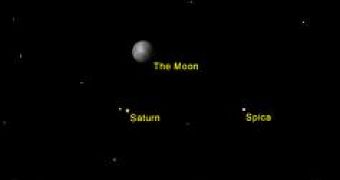In the next three early mornings, the moon will pass close to three space bodies – a star and two planets – offering us a spectacular bright sight in the night sky.
The first encounter is to take place Sunday, December 9, when the moon, slightly growing, will appear above the east-southeast horizon, coming close to Spica, the brightest star of the constellation Virgo.
Starting around 2:45 a. m. local time, the phenomenon will be visible from the Earth around 5-6 a. m., above the southeast horizon, Space reports.
Spica, also known as the “Daughter of the Harvest” is the 16th brightest star in the galaxy, its fame being traced back to the ancient mythology, where it was related to several gods and goddesses, such as Persephone and Ceres.
On Monday, December 10, the moon visibility will decrease considerably and, moving below the lower left of Spica, it will get closer to Saturn, the second largest planet in our Solar System and one of the most spectacular celestial bodies in our sky.
The sky meeting will be visible on Sunday at dawn above the southeastern horizon. The moon is expected to manifest a steady yellow glow, while Saturn is to appear in an impressively bright light.
The past Thursday, November 29, Saturn was object to a phenomenon first time occurring since June 2006. Having crossed the border of Virgo, the planet headed to the constellation of Libra and went into a position where its fascinating rings could be seen from Earth even in small telescopes.
Finally, on Tuesday, December 11, the moon will complete its series of celestial meetings by coming close to Venus, the brightest planet ever known.
The moon, the fifth largest satellite in our Solar System and the only natural satellite of the Earth, moves around the Earth completing an entire orbit in about 27.3 days, continuously changing its position relative to the other celestial bodies.

 14 DAY TRIAL //
14 DAY TRIAL //